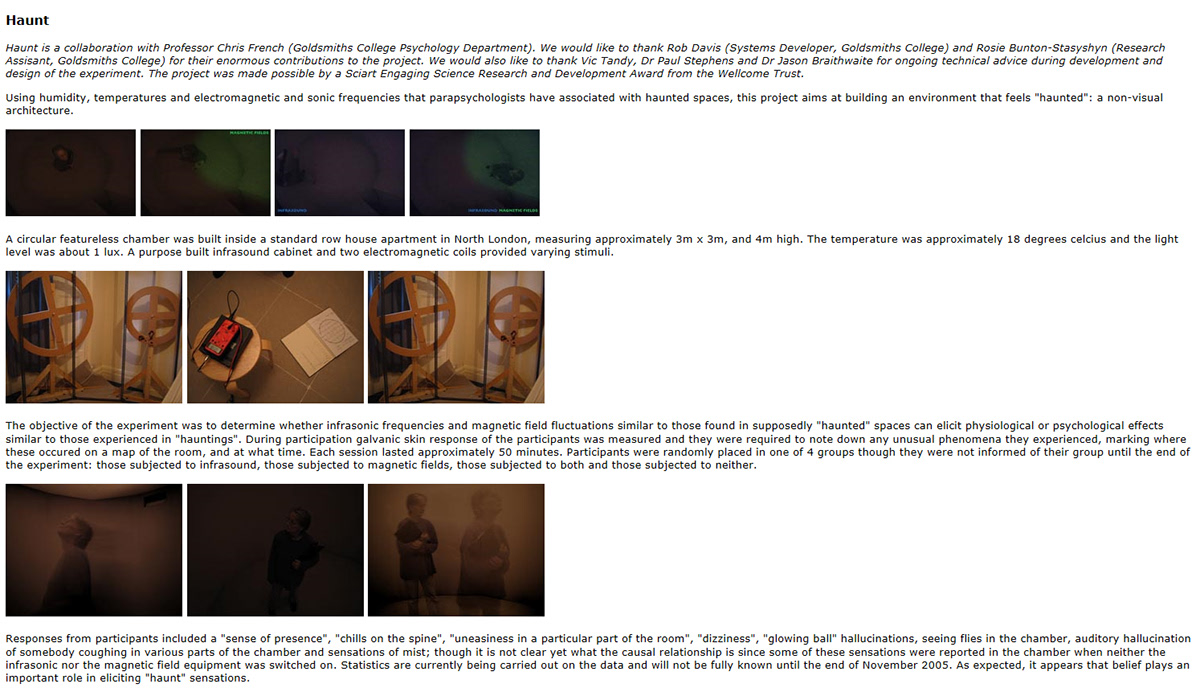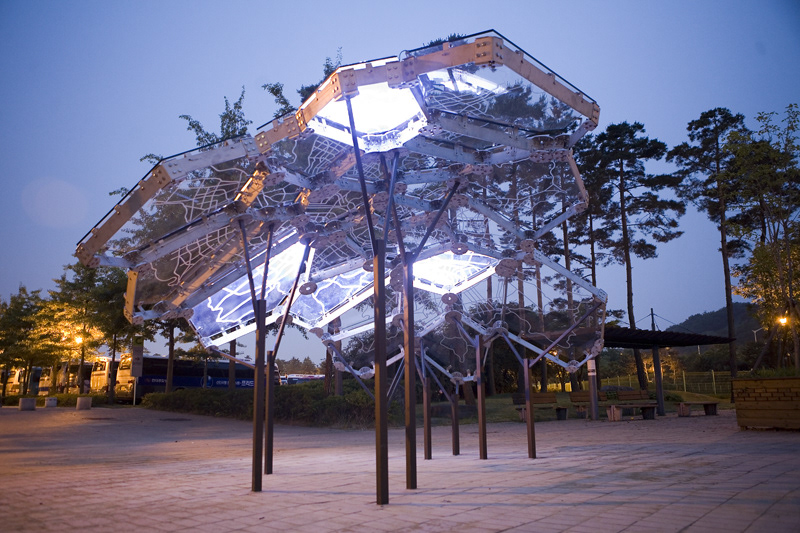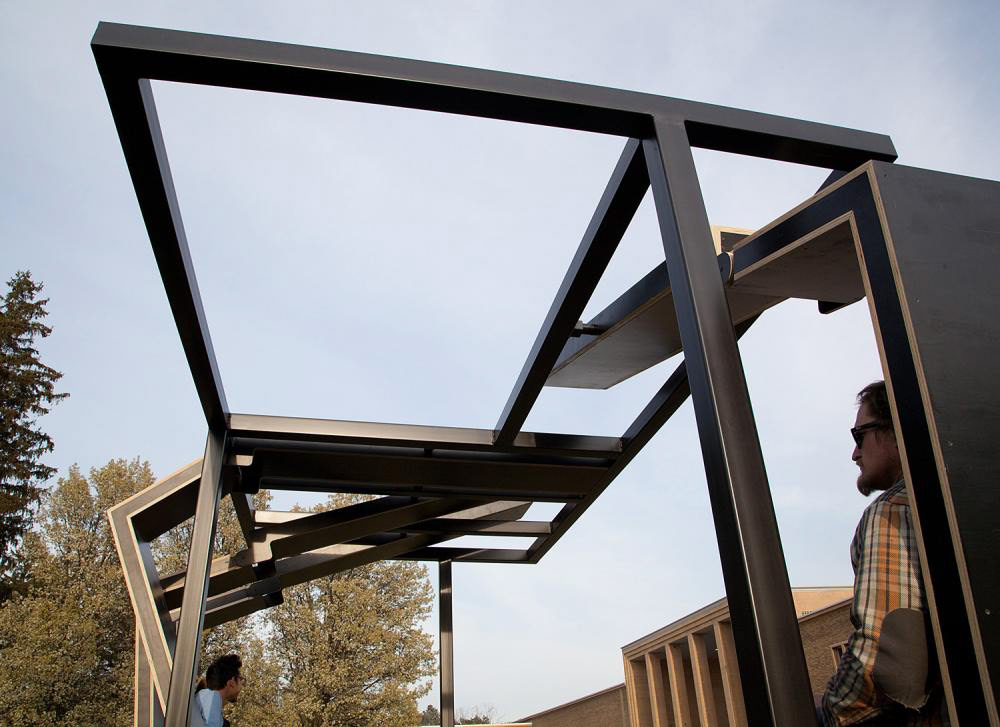Precedent Studies
Design X - Spring 2014 - Professor Kihong Ku
Collaborators: William Brostowicz & Maria Shore
Metamorphosis - Shimmer
Phillips Design
Facilitate well-being through surprise, movement, natural noise management, air movement and natural light dispersion Transform to change the interior characteristics of a space in response to people and the atmospheric/lighting conditions outside
Light-Touch Installation
Haptic Architects
Link: http://www.dezeen.com/2013/02/08/light-touch-installation-by-haptic/
Reciprocal Space
Ruairi Glynn
Reciprocal Space allows for human input to influence how psychical space is formed. This allows for users to respond and change how to interact with space. This allows for users to tinker and think about the space they are in. The project also learns from the user and uses Bio-Feedback loops to adjust space.
Interactive Pillar Field
Link: http://www.youtube.com/watch?v=SAeys1fK3Zo
Ada - Intelligent Room
Link: http://onlinelibrary.wiley.com/doi/10.1002/ad.20/pdf

E-Motive House


E-Motive House
Link: http://www.oosterhuis.nl/quickstart/index.php?id=348

Haunt
Designer: Usman Haque & Chris French
Designer Usman Haque teams up with a Psychology Professor Chris French to design a space that would make the Human psyche think the space is haunted. The team used objective analysis of Haunted spaces to come up with a spatial qualities to design with. The team noticed a correlation between infrasound, humidity, temperature, air movement, and electromagnetism that gave the feeling of being in a haunted space. These studies were used to make a space that is haunted but if we can design a space prevents theses conditions to happen, We can design spaces that are pleasant to experience. A description of each of their spatial condition defined by the team is located below: •infrasound: humans can hear sounds in the range of approximately 20 Hz to 20000 Hz. Infrasound (below the threshold of hearing) has featured in some apparently haunted spaces. Frequencies of 18 or 19Hz are just outside our ability to hear, however our bodies can feel these low rumbings subliminally. Such frequencies have been shown to elicit feelings of unease and to upset the sense of balance. •humidity: air quality tends to be fairly consistent in most inhabited spaces -- if air is moist in one area then it tends to disperse throughout the space. However, in apparently haunted spaces, one often encounters wide fluctuations in humidity from bone dry to uncomfortably muggy. •temperature: one would expect in most spaces for temperature to be fairly consistent throughout a space, given good air movement -- though there is quite a large change as one rises vertically through a space. Again, wide fluctuations in temperature, which can make hair stand on end, have been associated with apparently haunted spaces. •air movement: as a substance that is fundamental to our existence and surrounds us yet cannot be seen, air is often regarded with a certain awe. One of the most spooky experiences arises when air moves across our skin without any apparent cause. Air movement (in and of itself, as well as in combination with temperature and humidity effects) is therefore key to a "haunted" sensation. •electromagnetism: many studies have been undertaken to gauge the affects of electromagnetic fields (EMF) on people's perceptions. Some have argued that electric fields from appliances, antennae or nearby power cables have created sensations of haunting. Others note cases where none exist nearby. However, it is clear that EMF affects perception, more in some people than in others. As a result of this, the gaussmeter (which measures levels of EMF) is one of the main tools employed by ghost hunters. “Other factors also affect the perception of hauntings: the psychology of the individual; the desire to believe that something is happening (also observed when people encounter simulated intelligence systems); the social environment in which the hauntings are observed.“
Link: http://www.haque.co.uk/haunt.php

Living Light
Living Light is a building facade of the future that displays air quality and public interest in the environment. It is a permanent outdoor pavilion in Peace Park, across from World Cup Stadium in Seoul, Korea. Dynamic Terrain DYTE Dynamic Terrain is a dynamic architectonic surface. It demonstrates a possible future of an interactive system tat forms our surroundings depending on the action taken by the user. It wants to be a creature that we communicate to and play with. It functions as a skin that holds the human body in a dynamic and creative way. It is an area in which to experience the mix of digital and physical space. It is a surface without a fixed form, It’s form is virtual, and therefore adjustable and erasable. The software provides spatial possibilities that are translated in real time to the physical shape.
Link: http://www.janisland.com/DYTE.htm

Living Glass
David Benjamin and Soo-in Yang
The Living The Concept What is the idea behind this living glass? The Living Glass is a piece of responsive architecture which is actually a thin, transparent surface that ‘breathes’ when the carbon dioxide levels in a room become high. This Living Glass contains a silicone surface which is embedded with Flexinol wires and has parallel slits which open and close when the wires contract. Flexinol is a shape memory alloy that can contract to about 4-5% of its length due to electric currents. For this particular example, the air quality sensors were replaced with infrared proximity sensors. The prototype was tested for its ‘breathing skills’ by making someone pass in front of it. So, when any kind of movement was detected in front of the glass, the surface would bend and twitch in response to it. Thus, the actual experimentation was also performed with the glass being tested for CO2build-up, which would be detected by the CO2sensors in the glass. So, when the carbon dioxide levels rise, say during a long meeting or a conference, the microcontrollers send an electric charge through the wires, causing them to contract. The slits then open and fresh air comes in, while CO2is expelled out. The slits close again when the CO2levels inside the room are balanced again, thus proving to be very useful in controlling the air quality inside the room. This full-scale kinetic surface collects input through a range of sensors, processes the inputs through basic Stamp II microcontrollers, and triggers local movements of a human surface. After testing several surface materials, architects Benjamin and Yang zeroed in on the thin, transparent and lightweight material which had no mechanical parts or motors

Kinetic Pergula
Brian Lee
Uses basic mechanics and the weight of the seated body to manipulate form through the act of sitting.
Link: http://archinect.com/people/project/46609126/kinetic-pergola/46610329

Kinetic Pergula
Link: http://archinect.com/people/project/46609126/kinetic-pergola/46610329
Aperture
Frédéric Eyl and Gunnar Green
This facade installation is a interactive narrative display. It allows for uses to manipulate late that related to their location. The project when applied to large amounts of can allow for more light to be in a space as oppose to fewer people. This can have a major impact on how a user will feel in the space. This project is used to allow for a more interactive connection with the exterior of a building that can directly related to the human psyche. By inverting the process of this, you can connect people that are isolated to the larger campus and allow for groups to be closed off for communicate small group.
The Psychology of Urban Planning
http://www.archdaily.com/325492/the-psychology-of-urban-planning/
Can Design Influence Memory
Architecture Makes us More Creative
http://www.archdaily.com/353496/can-architecture-make-us-more-creative/
Interactive Architecture
